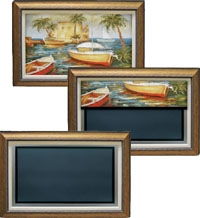Plasma Partners Page 3
HIDE IN PLAIN SIGHT
Recessing the TV makes it easier to cover the screen when it's not in use, and there are several products available to help wall-ensconced flat panels blend in. Eli Wilner & Co. sells high-end frames for flat-panel TVs ($10,000 to $20,000) in over 3,000 styles modeled after elaborately carved and decorated Old Master picture frames. Vutec and VisionArt offer frames, in dozens of styles, that can be combined with retractable artwork that slides over the TV screen (see below). Vutec's ArtScreens start at $2,800 for a 42-inch flat-panel TV and go up to $5,500 for larger screens, while VisionArt's run between $3,500 and $7,500.

Maybe the best way to make a flat-panel set disappear is to make it, well, disappear. A custom installer can mount the TV so that it lifts out of a tabletop, drops from the ceiling, or pops out of a piece of furniture at the foot of a bed. Motorized flat-panel TV mounts ($1,000 to $5,000) are available from companies like Auton, Cabinet Tronix, Chief, Draper, and Ginni Designs. Installing the necessary hardware is best left to professionals like CEDIA-certified installers (cedia.net has a free finder service).
OFF THE WALL
While hanging a flat-panel set on the wall is a popular and attractive option, many people are finding that it's more convenient and practical to simply place it on a tabletop stand ($200 and up) or even in an existing cabinet. As these TVs have become more popular, companies such as BDI, Bell'O, Boltz, Green Design, Salamander, Sanus, and Soricé have created a wide variety of furniture to house them. If you want something more elaborate or specifically tailored to your own home, interior designers like Cliff Young, Ltd. offer high-end cabinets or can custom-build furniture.
Another option is to modify a piece of existing or new furniture to accommodate the flat-panel TV and other components. "I've seen people keep the exterior of their rustic furniture intact," Garipay says, "but inside is all this high-tech gear." But such retrofitting can get elaborate. "One client had a huge cabinet he'd used for a big rear-projection TV," he says. "I had a cabinetmaker build shelves in the opening used by the old TV, and I put a 60-inch plasma on the top shelf with a tabletop mount. Below the TV are shelves for the equipment, and we also built a shroud around the screen to hide the empty space."




























































